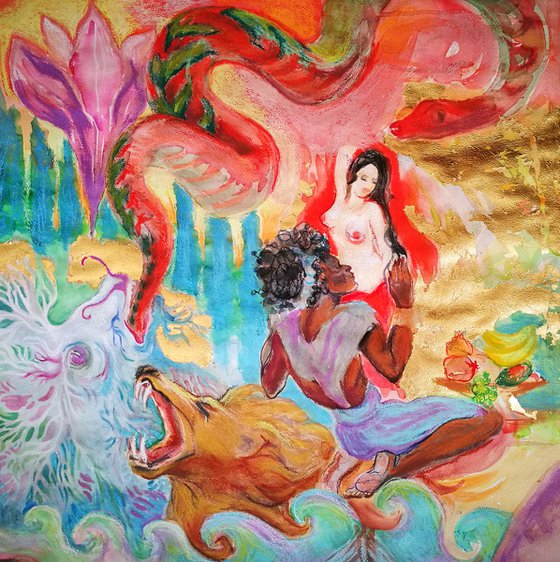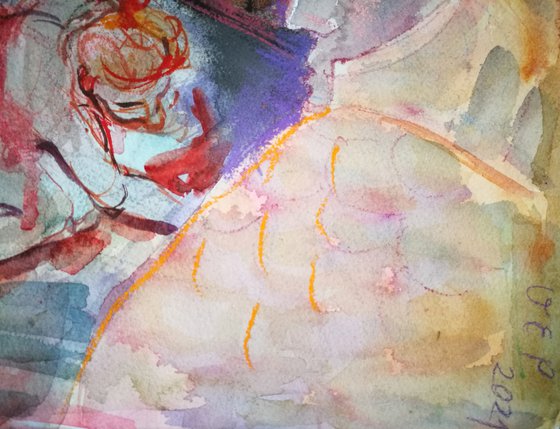- By medium
- By subject
- By budget
- Sales
- Gift cards
- Discover all art
- Artists
- Editors’ picks
- Ideas
Original artwork description:
A scene with lovers, armored elephant and mystic snake from series "Salammbô. Le royaume perdu", based on French novelist Gistave Flaubert's historical novel "Salammbô".
The great French writer Gustave Flaubert (1821-1880) goes to Carthage to seek refuge - in this case from the uproar caused by his previous novel "Madame Bovary". Flaubert travels around North Africa, thoroughly gets to know the testimonies of historians, orientalists and archaeologists of his time; more than four years of studies culminate in a novel “Salammbô” centered on the mercenary revolt in Carthage (240-238 AD) between the First and Second Punic Wars, as well as the femme fatale, the warlord Hamilcar Barca's (died around 228 AD) daughter Salammbô, priestess of the goddess Tanita. An inextricable tangle of passions is intertwined around her.
Salammbô is a figment of Flaubert's imagination (sources say that Hamilcar had a daughter, maybe even two or three, but neither their names nor their life stories are yet known to us). Flaubert endowed her with youth, beauty, a little mystical exaltation and almost desperate courage. The lust inspired by Salammbô leads the rebel leader Matho to go conquer Carthage and die an agonizing death at the end of the novel. Erotic passions merge with political and religious ones in the novel; brave warriors, passionate lovers and wise priests inhabit a space where the sacred is indistinguishable from the profane. Here there are both cruel battles and torture of enemies, as well as insanely magnificent feasts; here children are sacrificed to Moloch and songs of praise are sung to Tanita, the simultaneously virginal and maternal goddess of war, the Moon and female fertility. Flaubert portrays all these scenes in extreme detail, with the perfectionism of a naturalist, while not losing the pathos of a romantic.
Materials used:
Watercolor, pastel and gold leaf on paper
Tags:
#love #fantasy landscape #french literature #war elephant #salammboEven Lovers Will Die (2021) Watercolour
by Velta Emilija Platupe
£367.95
- Watercolour on Paper
- One of a kind artwork
- Size: 58 x 112 x 0.1cm (unframed) / 58 x 112cm (actual image size)
- Signed on the back
- Style: Surrealistic
- Subject: People and portraits
Loading
Original artwork description
A scene with lovers, armored elephant and mystic snake from series "Salammbô. Le royaume perdu", based on French novelist Gistave Flaubert's historical novel "Salammbô".
The great French writer Gustave Flaubert (1821-1880) goes to Carthage to seek refuge - in this case from the uproar caused by his previous novel "Madame Bovary". Flaubert travels around North Africa, thoroughly gets to know the testimonies of historians, orientalists and archaeologists of his time; more than four years of studies culminate in a novel “Salammbô” centered on the mercenary revolt in Carthage (240-238 AD) between the First and Second Punic Wars, as well as the femme fatale, the warlord Hamilcar Barca's (died around 228 AD) daughter Salammbô, priestess of the goddess Tanita. An inextricable tangle of passions is intertwined around her.
Salammbô is a figment of Flaubert's imagination (sources say that Hamilcar had a daughter, maybe even two or three, but neither their names nor their life stories are yet known to us). Flaubert endowed her with youth, beauty, a little mystical exaltation and almost desperate courage. The lust inspired by Salammbô leads the rebel leader Matho to go conquer Carthage and die an agonizing death at the end of the novel. Erotic passions merge with political and religious ones in the novel; brave warriors, passionate lovers and wise priests inhabit a space where the sacred is indistinguishable from the profane. Here there are both cruel battles and torture of enemies, as well as insanely magnificent feasts; here children are sacrificed to Moloch and songs of praise are sung to Tanita, the simultaneously virginal and maternal goddess of war, the Moon and female fertility. Flaubert portrays all these scenes in extreme detail, with the perfectionism of a naturalist, while not losing the pathos of a romantic.
Materials used:
Watercolor, pastel and gold leaf on paper
Tags:
#love #fantasy landscape #french literature #war elephant #salammbo14 day money back guaranteeLearn more





